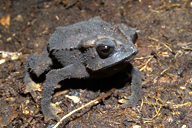|
Description
In an adult male the SVL measured to be 23.4 millimeters. SVL in adult females ranges from 26 to 37.4 millimeters. Cranial crest are well-developed above small eyes that contain a horizontally elliptical pupil. Head is more broad than long. The skin on the surface of the upper head is co-ossified to the skull. The parotoid glands are smooth egg shapes that are marginally smaller than area of the upper eyelid. There are no vocal slits or sacs. There are pointed warts on the upper surface of the thighs. On both hands and feet the first digit is shortened and surrounded by an extensive amount of webbing that forms ample padding. Finger I is shorter than finger II. In adult males finger I has a light-colored nuptial pad. Webbing is also extensively present on the toes, where toe I and II have no distinction from one another.
General color present on upper surfaces is gray to orange. A dark lateral stripe runs down from the parotroid to the groin. Occasionally a specimen will have an orange mark posterior to the parotoid glands. Ventor is light brown with bluish complexion. Distribution and Habitat
Country distribution from AmphibiaWeb's database: Costa Rica, Panama
In habits the Atlantic versant southeastern Costa Rica and adjacent to northeastern Panama between 1,051 to 2,040 meters a.s.l. in humid premontane slopes. Specimens were found in deep forest. Life History, Abundance, Activity, and Special Behaviors
Crepidophryne epiotica is presumed to be active above ground for a short period of time each year. Observations of a preserved female showed eggs have no pigmentation.
References
Savage, J. M. (2002). The Amphibians and Reptiles of Costa Rica:a herpetofauna between two continents, between two seas. University of Chicago Press, Chicago, Illinois, USA and London.
Species Account Citation: AmphibiaWeb 2010 Incilius epioticus <https://amphibiaweb.org/species/322> University of California, Berkeley, CA, USA. Accessed Jun 1, 2025.
Feedback or comments about this page.
Citation: AmphibiaWeb. 2025. <https://amphibiaweb.org> University of California, Berkeley, CA, USA. Accessed 1 Jun 2025.
AmphibiaWeb's policy on data use.
| 



 Map of Life
Map of Life